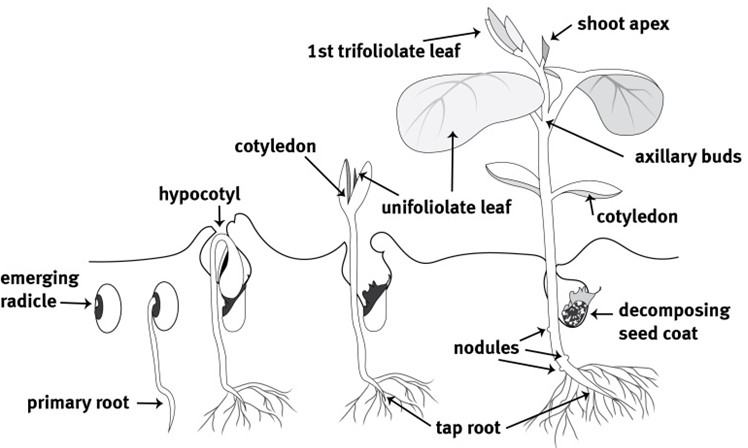Soybean Growth Stages Defined
Growth stages of soybeans is divided into vegetative growth stages (V) and reproductive growth stages (R). Subdivisions of the V stages are designate numerically as V1, V2, V3, through V(n); except the first two stages, which are designated as VE (emergence) and VC (cotyledon stage). The last V stage is designated as V(n) where (n) represents the number for the last node stage of the specific variety. The (n) stage will fluctuate with variety and environmental differences. The vegetative stages and reproductive stages are designated numerically with their common names in Table 1.
Table 1. Vegetative and Reproductive Stages of a Soybean Plant*
Vegetative Stages
|
Reproductive Stages
|
VE = emergence
|
R1 = beginning bloom
|
VC = cotyledon
|
R2 = full bloom
|
V1 = first node
|
R3 = beginning pod
|
V2 = second node
|
R4 = full pod
|
V3 = third node
|
R5 = beginning seed
|
V4 = forth node
|
R6 = full seed
|
V5 = fifth node
|
R7 = beginning maturity
|
V(n) = nth node
|
R8 = full maturity
|
*This system accurately identifies the stages of a soybean plant. However, all plants in a given field will not be in the same stage at the same time. When staging a field of soybeans, each specific V or R stage is defined only when 50 percent or more of the plants in the field are in or beyond that stage.
Vegetative Stages
The V stages (node stages) following VC are defined and numbered according to the uppermost fully developed leaf node. A fully developed leaf node is one that has a leaf above it with unrolled or unfolded leaflets. In other words, the leaflet edges have begun to unroll and are no longer touching. The V3 stage, for example, is defined when the leaflets on the 1st (unifoliolate) through the 4th node leaf are unrolled. Similarly, the VC stage occurs when the unifoliolate leaves have unrolled.
The unifoliolate leaf node is the first node or reference point from which to begin counting upward to identify upper leaf node numbers. This node is unique in that the unifoliolate (simple) leaves are produced from it on opposite sides of the stem and are borne on short petioles. All other true leaves formed by the plant are trifoliolate (compound) leaves borne on long petioles and are produced singularly (from different nodes) and alternately (from side to side) on the stem.
The cotyledons, which are considered as modified leaf storage organs, arise opposite on the stem just below the unifoliolate node. When the unifoliolate leaves are lost through injury or natural aging, the position of the unifoliolate node can still be determined by locating the two leaf scars on the lower stem that permanently mark where the unifoliolate leaves has grown. These unifoliolate leaf scars are located just above the two opposite scars which mark the cotyledonary node position. Any leaf scars above the opposite unifoliolate scars appear singularly and alternately on the stem, and mark node positions where trifoliolate leaves had grown.

Reproductive Stages
Subdivisions of the reproductive stages are designated numerically R1 through R8 and described below.
Stage
|
Description
|
R1
Beginning bloom
|
One flower open at any node on main stem
|
R2
Full bloom
|
Open flower at one of the two uppermost nodes
on main stem with a fully developed leaf.
|
R3
Beginning pod
|
Pod 3/16 inch long at one of the four uppermost nodes on main stem with a full developed leaf.
|
R4
Full pod
|
Pod ¾ inch long at one of the four uppermost nodes on main stem with a fully developed leaf
|
R5
Beginning seed
|
Seed 1/8 inch long in a pod at one of the four uppermost nodes on the main stem with a fully developed leaf.
|
R6
Full seed
|
Pod containing a green seed that fills pod cavity
at one of the four uppermost nodes on main stem with fully developed leaf.
|
R7
Beginning maturity
|
One normal pod on the main stem that has reached its mature color
|
R8
Full maturity
|
95% of the pods have reached their mature color
|








